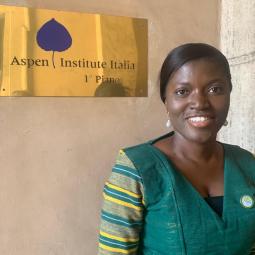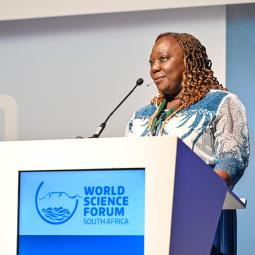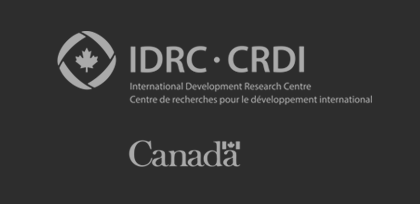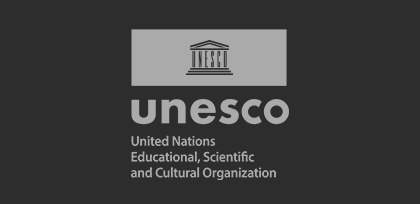OWSD Nigeria National chapter presents Climate Change Resilient Solutions for Reducing Emissions and Protecting Natural Ecosystems to improve food availability and Security
April 09, 2024
OWSD Nigeria University of PortHarcourt Branch Series of Scientific Communications: Chinyere C. Amadi on Climate Change Resilient Solutions for Reducing Emissions and Protecting Nature
Climate Change Resilient Solutions for Reducing Emissions and Protecting Natural Ecosystems to Improve Food Availability and Security
By
Dr. Chinyere Caroline Amadi
Background
Improving nutrition and food security in a climate-changing world is a task we owe ourselves as humans who inhabit the earth and need food for survival. Nutrition, food safety, and food security are cross-cutting issues that permeate the entire life course from conception to old age. Food is not only essential for sustenance and physical survival but also influences various aspects of human life, including nutrition and health, cultural identity, economic stability, cognitive function, environmental sustainability, social well-being, and food security. Food, fuel, and other materials are critical for food security, energy resources, and a productive economy. Achieving Zero hunger as the second Sustainable Development Goal’s target is a means to achieve food availability and security. Food security is a state in which all individuals have access to safe, nutritious food that meets their dietary needs and preferences for an active and healthy life. It encompasses four dimensions: availability, access, utilization, and stability.
According to WHO, 2008, about 800 million people are undernourished and about 170 million infants and young children are underweight. Each year, more than five million children die from undernutrition. Food security issues are related to the attainment of the Millennium Development Goals and other international commitments related to nutrition and food safety, including the prevention of foodborne, zoonotic, and diet-related chronic diseases and micronutrient malnutrition. Climate change could affect food security at the global, regional, and local levels, it could also disrupt food availability, reduce access to food, and affect food quality by creating anthropogenic imbalance in the ecosystem.
Climate change, causes, and global consequences
According to the United Nations Framework Convention on Climate Change (UNFCCC,2009), Climate change is attributed directly or indirectly to human activity that alters the composition of the global atmosphere and is in addition to natural climate variability observed over comparable periods. Natural processes interacting with the sun such as water and energy cycles occur naturally and are caused by natural phenomena such as slow shifts in the earth’s orbit and changes in solar and volcanic activity. Therefore, Anthropogenic Climate change or natural processes that are already occurring and predicted to occur result in increasing air and sea surface temperatures, changing rainfall patterns, sea level rise, ocean acidification, and frequency and intensity of extreme events such as droughts, floods, and tropical cyclones. However, anthropogenic changes are expected to happen much more rapidly and have caused sudden shifts in the climate by releasing greenhouse gases than natural changes in the climate posing enormous challenges to both natural and human systems (IPCC, 2014). Anthropogenic climate change is one of the greatest environmental challenges the world faces today (Marques et al., 2010).
Greenhouse gas (GHG) emissions have increased rapidly since the Industrial Revolution in the 1800s and reached their highest level in the decade in 2010. There has been a marked increase in global surface temperature of (0.89OC) between 1901-2012 as a result of the release of these GHGs (IPCC Assessment Report 5,2014). Continued high emissions would lead to mostly negative impacts on biodiversity, ecosystem services, and economic development, amplifying risks for livelihoods, food, and human security (Pachauri and Meyer,2014). These major gases(Carbon dioxide(CO2), Methane(CH4) Nitrous oxide,(N2O), Hydrofluorocarbons (HFCs), Perfluorocarbons (PFCs), and Sulphur hexafluoride (SF6) and other minor gases contribute to global warming.
Global warming refers to the gradual increase, observed or projected, in global surface temperature, as one of the consequences of radioactive forcing caused by anthropogenic emissions. UNFCCC and its Kyoto Protocol recognized six greenhouse gases:
Table 1: The main greenhouse gases (UNFCCC,2009)
|
|
Gases |
Sources |
Share of Global emissions in 2004 |
|
1 |
Carbon dioxide(CO2) |
The consumption of energy from burning fossil fuels and deforestation |
76.7% with 56.6% from fossil fuel use |
|
2 |
Methane |
From Agricultural activities, Energy production, and wastes |
14.3% |
|
3 |
Nitrous Oxide (N2O) |
From Agricultural activities, Energy production, and wastes |
1.1% |
|
4 |
Hydroflourocarbons(HFCs) |
Used as replacements for ozone-depleting substances |
|
|
5 |
Perfluorocarbons(PFCs) |
|
|
|
6 |
Sulphur hexafluoride(SF6) |
Used in some industrial processes and electric types of equipment |
Global warming has led to changes in cloud patterns, snow cover, rainfall, wind patterns, ocean currents, and the distribution of plant and animal species. This increase in global warming could cause ecosystems and climate-sensitive species permanently lost. When greenhouse gases are emitted into the atmosphere, many remain there for long periods ranging from a decade to many millennia. Over time, these gases are removed from the atmosphere by chemical reactions or by emissions sinks, such as the oceans and vegetation, which absorb greenhouse gases from the atmosphere. Figs 1 to 3 show Global average and ocean surface temperature anomaly over 150 years, Global average sea level change over 150 years, and Global average greenhouse concentrations gas over 150 years.
Fig.1.Global average land and ocean surface temperature anomaly over 150 years(Adapted from IPCC Climate change Synthesis Report, 2014)
Fig.2.Global averaged sea level change over 150 years(Adapted from IPCC Climate change Synthesis Report, 2014)
Fig.3.Global averaged greenhouse concentrations gas over 150 years(Adapted from IPCC Climate change Synthesis Report, 2014)
The Ecosystem absorbs greenhouse gases from the atmosphere over time. Ecosystems provide the conditions necessary for local and commercial food production as well as for subsistence living, provide habitat to wild plants and animals, promote various food chains and food webs, control essential ecological processes, and promote lives. It is involved in the recycling of nutrients between biotic and abiotic components and it helps in maintaining the usual flow of energy in the Carbon Cycle, Energy Cycle, Nitrogen Cycle, Oxygen Cycle, and Water Cycle. However, our ecosystem is been threatened by climate change factors, exacerbating sea and terrestrial food scarcity at local and global levels.
Fig.4. Types of Ecosystem(Adapted from www.scribd.com)
Effects of climate change on food availability
The global food system today faces the significant challenge of feeding more people amid dwindling natural resources and a more fragile natural environment(Fan,2016). About 520 million people (i.e., around 8% of the world’s population) depend on seafood as a source of protein, income or family stability (FAO, 2009). Sudden rises in temperature and acidification can lead to the loss of marine habitats and species, this is because high temperatures reduce oxygen solubility in water, and favor the survival of parasites and bacteria which reduce fish survival, as well as growth and reproductive success of wild populations and aquaculture species(Halls, 2009). Shifting ocean currents and warming waters are changing the distribution of fish stocks and altering the structure of ecosystems. Planktons at the bottom of the marine food chains are sensitive to water temperatures and oxygen concentrations. They can die off if the water gets too warm. Animals further up the food chain, like whales can suffer food shortages when this happens.
Climate change affects both subsistence and commercial farming, it causes an increase in pests and diseases caused by rising temperatures, thereby declining agricultural production. Again, floods, droughts, heatwaves, hurricanes, and wildfires can drive down crop yields, destroy livestock, and interfere with the transport of food. The yields of major commodity land crops like corn, rice, and oats would be affected by climate change. According to FAO,2015, temperatures are likely to increase between 1.5 to 4oC in this century. Projections on yield reduction show a drop of up to 50% and crop revenue is forecast to fall by as much as 90% by 2100. Climate change would cause soil fertility and moisture to reduce. Climate change is expected to increase the frequency of rainfall which would harm crops by eroding soil and depleting nutrients (The Mail and Guardian,2023). Deteriorating pasture conditions, and livestock losses in both farming and pastoral communities are conditions worsened by climate change.
Effects of climate change on food security
Climate change can have an impact on food security, increased climate variability, and increased frequency and intensity of extreme events would affect food supply, access, and availability. An increase in food demand, an increase in food price, the disappearance of agricultural plant species, food losses and food waste, water scarcity, and limitations in the availability of land are expected to occur.
Climate change resilient solutions
This refers to the ability to anticipate and prepare for, as well as adapt to, absorb, and recover from the impacts of climate change. Generally, there is no ‘one-size-fits-all solution, adaptation can range from building flood defenses, setting up early warning systems, and switching to drought-resistant crops. Crop varieties and management; including land use change and innovative breeding techniques, water and soil management, including agronomic practices; farmer training and knowledge transfer. Ocean acidification is fueled by the release of GHGs, especially Carbon dioxide which affects fish population and growth, the most effective way to reduce it is to reduce the use of fossil fuels, this can reduce the harm to ecosystems.
Conclusion
The oceans and vegetation are parts of our ecosystem. They act as sinks that absorb greenhouse gases from the atmosphere after a long period. These gases cause lots of changes in the natural chemistry in these ecosystems which affect their natural balance, hence their ability to contribute adequately to food chains. Reduction, adaptation, and mitigation strategies can help to ameliorate the risk of climate change on food availability and security.
REFERENCES
Fan, S., & Brzeska, J. (2016). Sustainable food security and nutrition: Demystifying conventional beliefs. Global food security, 11, 11-16.
FAO, 2009.Climate change implications for fisheries and aquaculture. In: The State of Fisheries and Aquaculture 2008. Rome, Italy: FAO; 2008. pp. 87-91
Food and Agriculture Organization of the United Nations(FAO) 2015. How to Feed the World in 2050, Available online.
Hall,E.K(2009). Potential impact of climate change on fisheries and aquaculture in Nigeria. Retrieved from https://aquadocs.org.
Intercontinental Panel on Climate Change (IPCC)(2014). Summary of Report 5, Working group 1(The Physical Science Basis for Pacific Conference of Parties (COP) negotiators, Secretariate of the Pacific Regional Environment and Programme (SPREP), Alpia:p4.
Intercontinental Panel on Climate Change (IPCC)(2014). Working group 3, Assessment Report 5, ch5:p4.
Marques, A., Nunes, M. L., Moore, S. K., & Strom, M. S. (2010). Climate change and seafood safety: Human health implications. Food Research International, 43(7), 1766-1779.
Pachauri, R.Kand Meyer,L.A (2014). Climate Change Synthesis Report. Contribution of Working Groups I, II, and III to the Fifth Assessment Report of the Intergovernmental Panel on Climate Change(IPCC), Geneva, Switzerland, pp.80
The mail and guardian.2023. Climate change threatens agriculture in Africa. Retrieved from https://mg.co.za.
UNFCCC, 2009. The Need for Mitigation, Fact sheet, Pg.1
WHO, 2008. To improve nutrition, food safety, and food security, throughout the life course, and in support of public health and sustainable development. Retrieved from https://apps.who.int/gb/ebwha/pdf_files/MTSP-PPB/en_mtsp_p4.pdf







































